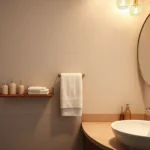We’ve all been there – staring at our outdated bathroom wondering how to transform it into a space we’ll actually love spending time in. Whether you’re dealing with cramped quarters or simply tired of the same old look your bathroom holds incredible potential for renovation magic.
Bathroom renovations consistently rank among the highest return-on-investment home improvements. We’re talking about turning your daily routine into a spa-like experience while boosting your home’s value. From budget-friendly updates that pack a visual punch to complete overhauls that’ll make your neighbors jealous the possibilities are endless.
The best part? You don’t need to expensive or hire a full construction crew to achieve stunning results. We’ll share proven renovation ideas that range from simple weekend projects to more ambitious transformations. Let’s jump into creative answers that’ll help you maximize your space enhance functionality and create the bathroom of your dreams.
Planning Your Bathroom Renovation Budget and Timeline
We’ve explored the groundbreaking potential of bathroom renovations, so now let’s tackle the crucial planning phase that determines your project’s success.
Setting Realistic Budget Expectations
Small bathroom updates typically range from $5,000 to $15,000 for essential improvements like fixtures, paint, and accessories. Mid-range renovations cost between $15,000 and $30,000, covering new tile installation, vanity replacement, and upgraded lighting. Full bathroom remodels reach $30,000 to $60,000 when you’re relocating plumbing, expanding space, or installing luxury features.
Labor costs consume 35% to 45% of your total budget across most renovation projects. Materials account for another 35% to 40%, while permits and unexpected issues typically add 10% to 20% more. We recommend setting aside an additional 20% contingency fund for surprises like water damage or outdated electrical systems.
Fixture quality significantly impacts your budget allocation strategy. Standard fixtures cost $200 to $800 per item, while premium options range from $800 to $2,500 each. Tile prices vary from $3 to $15 per square foot for ceramic options, jumping to $15 to $50 per square foot for natural stone materials.
Creating a Renovation Timeline
Demolition phase requires 2 to 5 days depending on your bathroom’s size and complexity. Plumbing and electrical rough-in work takes another 3 to 7 days, especially when moving fixtures or updating old systems. Drywall installation and repairs add 2 to 4 days to your schedule.
Tile installation demands 3 to 8 days for completion, varying with pattern complexity and material type. Fixture installation follows over 2 to 3 days, including vanity mounting, toilet placement, and shower door fitting. Final touches like painting, caulking, and accessory installation need 2 to 4 additional days.
Total project duration spans 3 to 6 weeks for complete renovations, though delays happen frequently. Permit approval adds 1 to 4 weeks before construction begins. Material delivery delays can extend timelines by several days or weeks.
| Renovation Phase | Duration | Key Activities |
|---|---|---|
| Planning & Permits | 2-6 weeks | Design finalization, permit approval |
| Demolition | 2-5 days | Removal of old fixtures, tiles, drywall |
| Rough-in Work | 3-7 days | Plumbing, electrical, HVAC updates |
| Installation | 1-2 weeks | Tile, fixtures, vanity, accessories |
| Final Touches | 2-4 days | Painting, caulking, cleanup |
Hiring Professionals vs. DIY Approach
DIY renovations can reduce costs by 50% to 70% when you handle painting, tile installation, and fixture mounting yourself. Simple tasks like vanity replacement, mirror hanging, and accessory installation require basic tools and moderate skill levels. Painting and caulking offer excellent starting points for first-time renovators.
Professional expertise becomes essential for plumbing relocations, electrical work, and structural modifications. Licensed contractors ensure code compliance and warranty protection for major installations. Tile work requires specialized tools and experience to achieve professional-looking results.
Hybrid approaches maximize savings while ensuring quality results. We suggest handling demolition, painting, and accessory installation yourself while hiring professionals for plumbing, electrical, and complex tile work. This strategy typically reduces total costs by 25% to 35% compared to full contractor pricing.
Skill assessment helps determine which tasks you can confidently tackle. Measure twice, cut once applies to all DIY work, especially tile cutting and fixture placement. Research local building codes before starting any electrical or plumbing modifications to avoid costly corrections.
Maximizing Small Bathroom Spaces With Smart Design
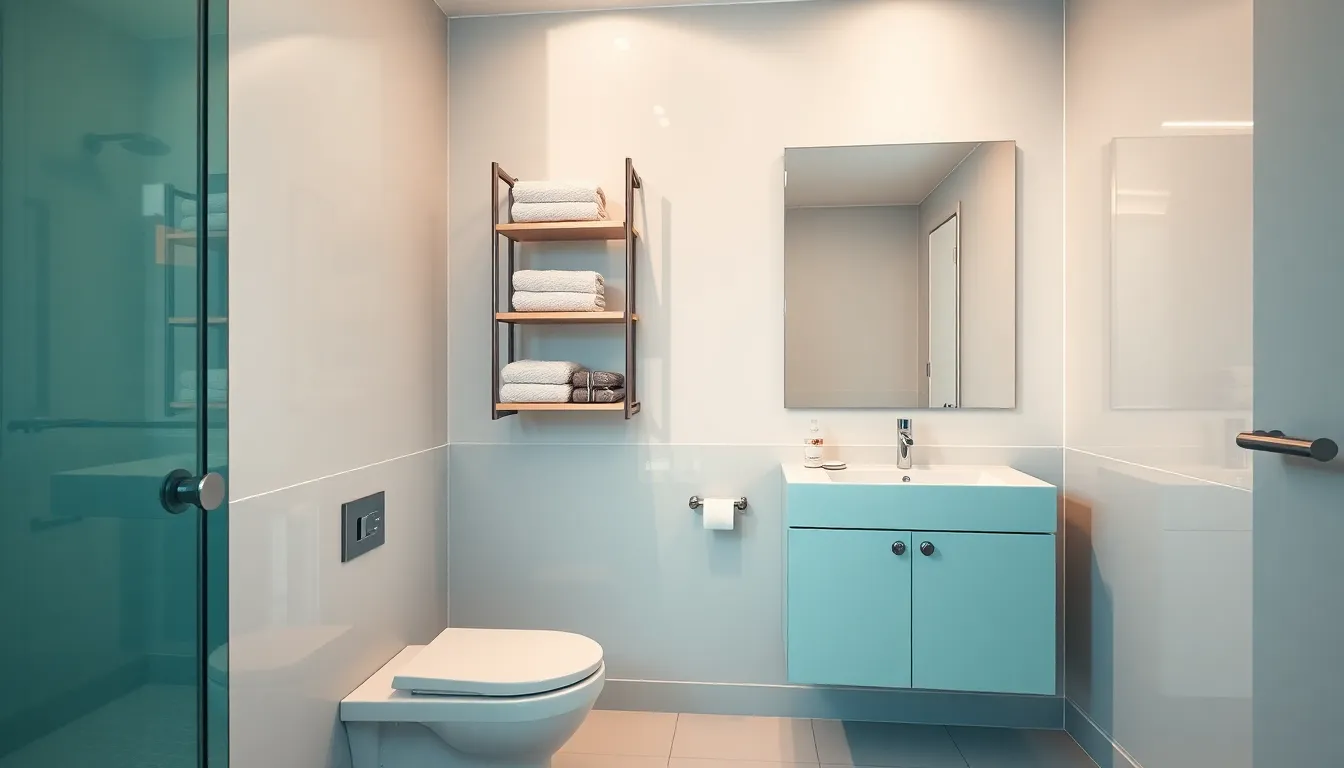
Transforming a cramped bathroom into a spacious sanctuary requires strategic design choices that create both visual and functional space. We’ll explore three powerful techniques that can dramatically improve your small bathroom’s functionality without major structural changes.
Installing Wall-Mounted Fixtures
Wall hung toilets revolutionize small bathroom layouts by freeing up valuable floor space and creating a cleaner appearance. These fixtures eliminate the need for a bulky base, making your bathroom feel more open while simplifying cleaning routines around the toilet area.
Wall mounted vanity units provide essential storage without consuming precious floor real estate. We recommend choosing units with drawers rather than doors to maximize accessibility in tight spaces, allowing you to store toiletries and essentials efficiently.
Wall mounted towel radiators serve dual purposes by keeping towels warm while maintaining clear floor lines. These fixtures add both comfort and visual spaciousness to your bathroom design, creating an uncluttered environment that feels larger than its actual dimensions.
Using Light Colors and Mirrors
Light colored paint schemes can instantly make your small bathroom feel more expansive and airy. We suggest using whites, soft grays, or pale pastels on walls and ceilings to reflect natural light and create the illusion of increased square footage.
Mirrors strategically positioned throughout the space multiply light sources and create depth perception. Large mirrors opposite windows reflect outdoor views, while multiple smaller mirrors can add visual interest without overwhelming the space.
Glossy finishes on tiles and fixtures further enhance light reflection capabilities. These surfaces bounce light around the room, contributing to the overall brightness and perceived spaciousness of your bathroom renovation.
Adding Vertical Storage Answers
Shelves mounted high on walls take advantage of often unused vertical space above eye level. We recommend installing floating shelves to store items you don’t use daily, keeping countertops clear while maintaining easy access to essentials.
Recessed shelving built into shower walls or between wall studs provides storage without protruding into the room. These niches can hold shampoo bottles, soap, and other bathing necessities without sacrificing any floor or wall space.
Over the toilet storage cabinets or open shelving units maximize the area above your toilet tank. This typically wasted space can accommodate towels, toilet paper, and cleaning supplies while maintaining the room’s clean lines and functionality.
Upgrading Your Shower and Bathtub Area
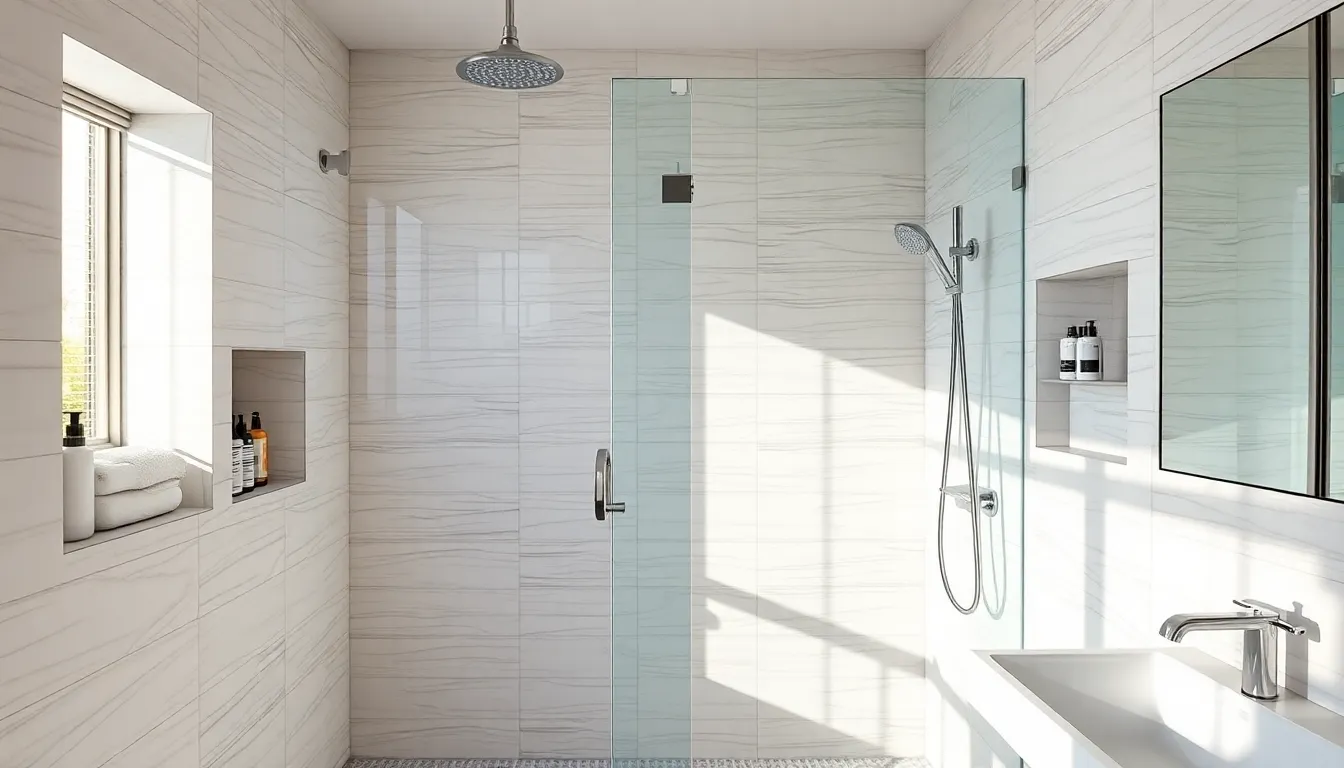
Transforming your shower and bathtub area creates the ultimate focal point for your bathroom renovation project. Modern upgrades in this space deliver both luxury and functionality while significantly boosting your home’s value.
Converting Tub to Walk-In Shower
Converting your traditional bathtub to a walk-in shower enhances accessibility and flexibility for daily use. This popular renovation choice works especially well for homeowners who prefer showering over bathing.
Design considerations play a crucial role when planning your tub-to-shower conversion. We recommend ensuring proper drainage systems are installed to prevent water accumulation. Non-slip surfaces become essential safety features that protect users from potential accidents.
Space optimization happens naturally when you remove bulky bathtubs from smaller bathrooms. Walk-in showers create an open, airy feeling that makes your bathroom appear larger than before. Glass enclosures or doorless designs further enhance this spacious sensation.
Accessibility improvements benefit users of all ages and mobility levels. Lower thresholds eliminate stepping over high tub walls, while grab bars can be seamlessly integrated into the design. These modifications future-proof your bathroom for aging in place.
Installing Rainfall Showerheads
Rainfall showerheads provide a luxurious spa-like experience by mimicking the sensation of standing under a natural waterfall. These fixtures transform your daily shower routine into a relaxing wellness ritual.
Water efficiency remains important when selecting rainfall shower systems. Look for models with WaterSense certification that maintain good water pressure while conserving resources. Many modern rainfall heads feature flow restrictors that reduce water usage without compromising performance.
Installation options include ceiling-mounted systems for authentic rainfall effects or wall-mounted versions for easier retrofitting. Ceiling installations require additional plumbing work but deliver the most realistic waterfall experience. Wall-mounted alternatives offer similar luxury with simpler installation requirements.
Multiple spray patterns enhance versatility in premium rainfall showerheads. Features like massage settings, mist options, and adjustable flow rates let you customize your shower experience. Smart rainfall systems even allow digital controls for temperature and flow preferences.
Adding Built-In Shower Niches
Built-in shower niches provide convenient storage while adding sophisticated style to your shower design. These recessed compartments eliminate the need for hanging caddies or corner shelves that create visual clutter.
Customization options allow niches to match your exact bathroom theme and storage needs. Single large niches work well for minimalist designs, while multiple smaller compartments suit families with varied product requirements. Lighting integration creates dramatic effects that highlight your niche design.
Material coordination ensures niches blend seamlessly with surrounding shower surfaces. Popular choices include matching tile, natural stone, or contrasting materials that create visual interest. Waterproof backing and proper sealing prevent moisture damage behind niche walls.
Placement strategies maximize both function and aesthetics in your shower space. Eye-level positioning provides easy access to frequently used items like shampoo and soap. Lower niches accommodate larger bottles, while corner installations use otherwise wasted space efficiently.
Choosing Modern Flooring Options for Durability
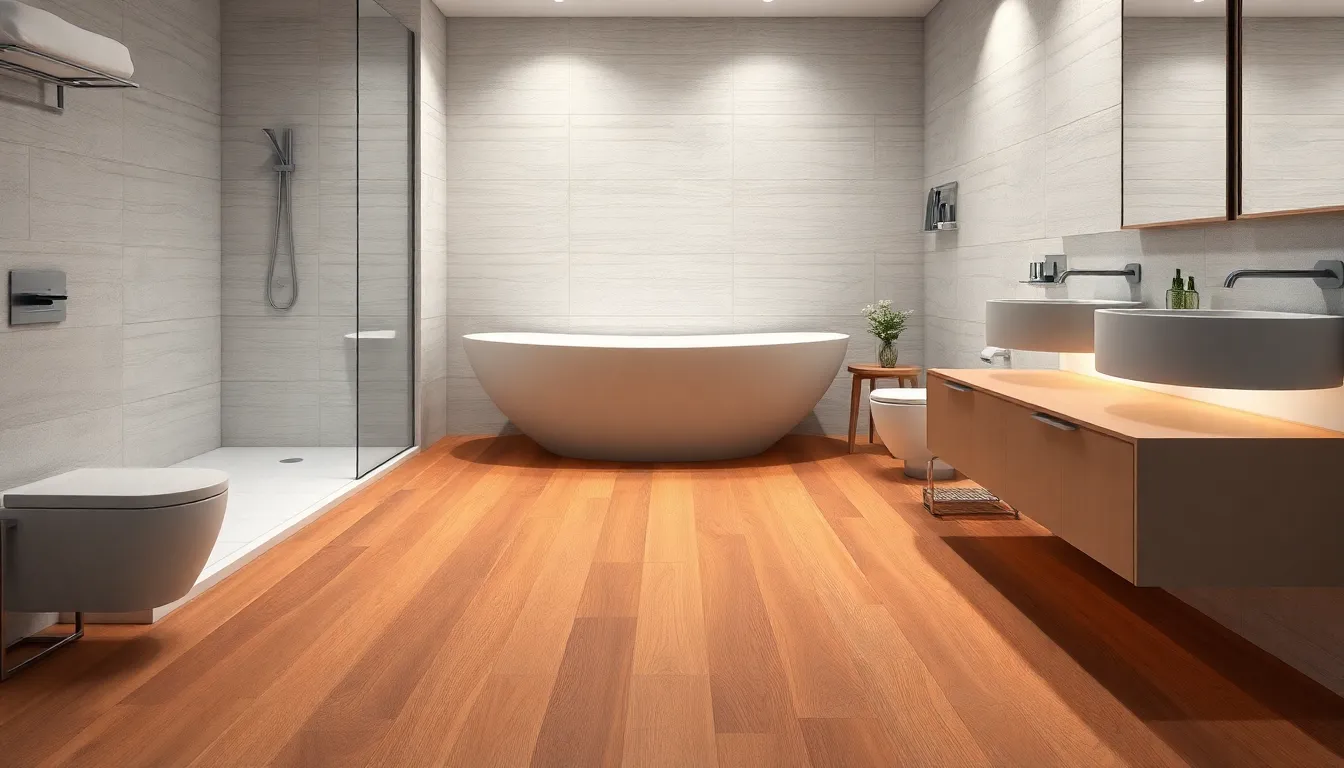
Flooring forms the foundation of any successful bathroom renovation, requiring materials that withstand constant moisture while delivering lasting performance. We’ll explore the top durable options that combine water resistance with style.
Luxury Vinyl Plank Benefits
Waterproof protection makes LVP an outstanding choice for bathroom environments where moisture levels remain consistently high. The waterproof core prevents warping, swelling, or mold growth that commonly affects other flooring materials.
Durability features include multi-layer construction that resists scratches, stains, and daily wear from household traffic. This robust design ensures long-lasting performance even in homes with children and pets who create additional wear patterns.
Aesthetic versatility allows LVP to mimic wood, stone, or ceramic tile appearances at significantly lower costs than natural materials. Countless designs and textures provide endless customization options for any renovation style.
Comfort advantages include softer, warmer surfaces compared to traditional tile flooring. This characteristic reduces slipping risks while providing more comfortable footing during daily routines.
Installation simplicity comes from click-lock or adhesive systems that enable DIY projects. Most homeowners can complete installation without professional help, creating substantial cost savings for renovation budgets.
Porcelain Tile Advantages
Extreme durability makes porcelain tile highly resistant to scratches, chips, and impacts from dropped items. High-traffic bathrooms benefit from this exceptional strength that maintains appearance over decades.
Water resistance properties include minimal absorption rates that prevent moisture penetration. This characteristic effectively prevents mold and mildew growth while withstanding humidity fluctuations.
Design flexibility offers wide ranges of colors, patterns, and finishes for premium appearances. Customization options accommodate both modern minimalist and classic traditional renovation styles.
Low maintenance requirements eliminate frequent sealing needs unlike natural stone alternatives. Easy cleaning protocols keep surfaces looking fresh with standard household products.
Heated Floor Installation
Comfort enhancement provides consistent warmth underfoot throughout cold seasons. This feature proves especially valuable in climates where bathroom floors become uncomfortably cold during winter months.
Energy efficiency comes from modern electric and hydronic systems with programmable controls. These systems deliver targeted heating while minimizing energy consumption compared to whole-room heating methods.
Compatibility options allow heated floor installation under both LVP (with manufacturer approval) and porcelain tile surfaces. This versatility enables luxury comfort regardless of primary flooring material selection.
Installing Energy-Efficient Lighting Solutions
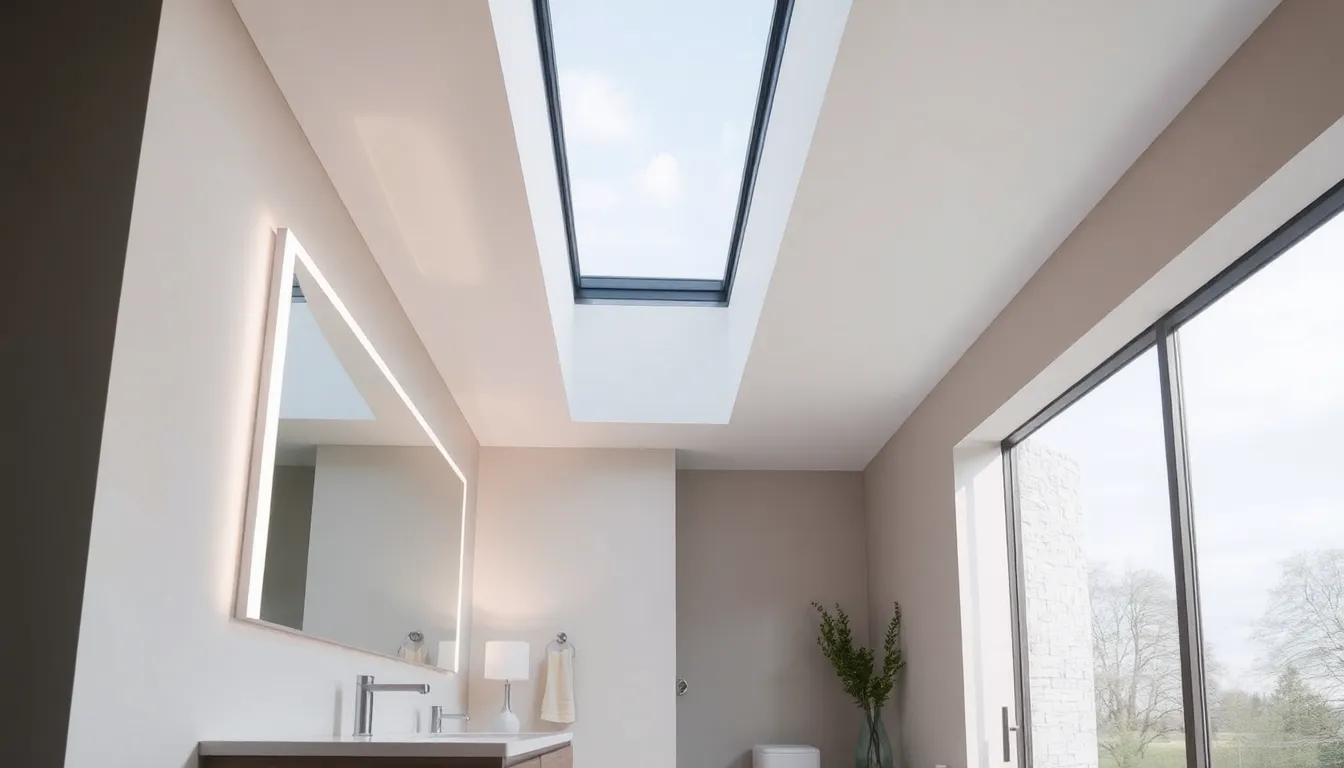
Modern lighting technology transforms bathroom functionality while reducing energy costs. We’ll explore three cutting-edge answers that enhance both ambiance and efficiency.
LED Vanity Lighting
LED vanity fixtures revolutionize bathroom illumination by consuming significantly less energy than traditional incandescent or halogen bulbs. We recommend these fixtures because they offer exceptional longevity and provide multiple color temperature options to match your personal preferences. Modern LED vanity lights feature sleek designs that complement contemporary bathroom aesthetics perfectly.
Installation benefits extend beyond energy savings. LED fixtures generate minimal heat, making them ideal for bathroom environments where moisture and temperature control matter. We’ve found that LED vanity lighting delivers consistent brightness throughout its lifespan, eliminating the gradual dimming common with traditional bulbs.
Color temperature flexibility allows you to customize the lighting experience. Warm white LEDs (2700K-3000K) create a relaxing atmosphere, while cool white options (4000K-5000K) provide crisp illumination for detailed grooming tasks. Many homeowners choose adjustable LED fixtures that offer both temperature ranges in one unit.
Skylight Installation Options
Skylights introduce natural light that brightens bathroom spaces while reducing daytime artificial lighting needs. We recommend considering both fixed and vented skylight models, each offering distinct advantages for different bathroom configurations.
Fixed skylights provide consistent natural illumination without moving parts that might require maintenance. Vented skylights offer the additional benefit of improved air circulation, helping to control moisture and enhance indoor air quality. Energy efficient glazing options include double or triple-pane glass with low-E coatings that minimize heat transfer.
Solar powered skylights represent the latest innovation in natural lighting answers. These units operate without electrical connections and can include automated rain sensors and programmable controls. Privacy concerns disappear with skylights since they eliminate the need for traditional windows while still flooding the space with natural light.
| Skylight Type | Energy Benefit | Installation Complexity | Cost Range |
|---|---|---|---|
| Fixed | Reduces daytime lighting by 60-80% | Moderate | $800-$1,500 |
| Vented | Lighting reduction plus ventilation | High | $1,200-$2,500 |
| Solar-powered | Maximum efficiency with automation | Moderate | $1,500-$3,000 |
Smart Dimmer Switch Integration
Smart dimmer switches provide precise brightness control that adapts to different times of day and personal preferences. We install these systems because they integrate seamlessly with LED lighting while offering remote smartphone control capabilities.
Programming features allow automatic brightness adjustments based on your daily routine. Morning settings can gradually increase light intensity to ease the transition from sleep, while evening modes dim to create a relaxing atmosphere. Remote control functionality means you can adjust lighting before entering the bathroom or while away from home.
Compatibility with low energy lighting systems makes smart dimmers particularly effective with LED vanity fixtures. These switches often include preset scenes, timer functions, and energy monitoring capabilities that track usage patterns. We prioritize moisture resistant or waterproof models specifically rated for bathroom environments to ensure safety and durability.
Integration with existing smart home systems creates a cohesive lighting network throughout your house. Voice control compatibility with systems like Alexa or Google Home adds convenience for hands free operation. The combination of LED vanity lighting, skylights, and smart dimmer switches results in a well lit, energy efficient, and user friendly bathroom space.
Updating Vanities and Storage for Better Organization
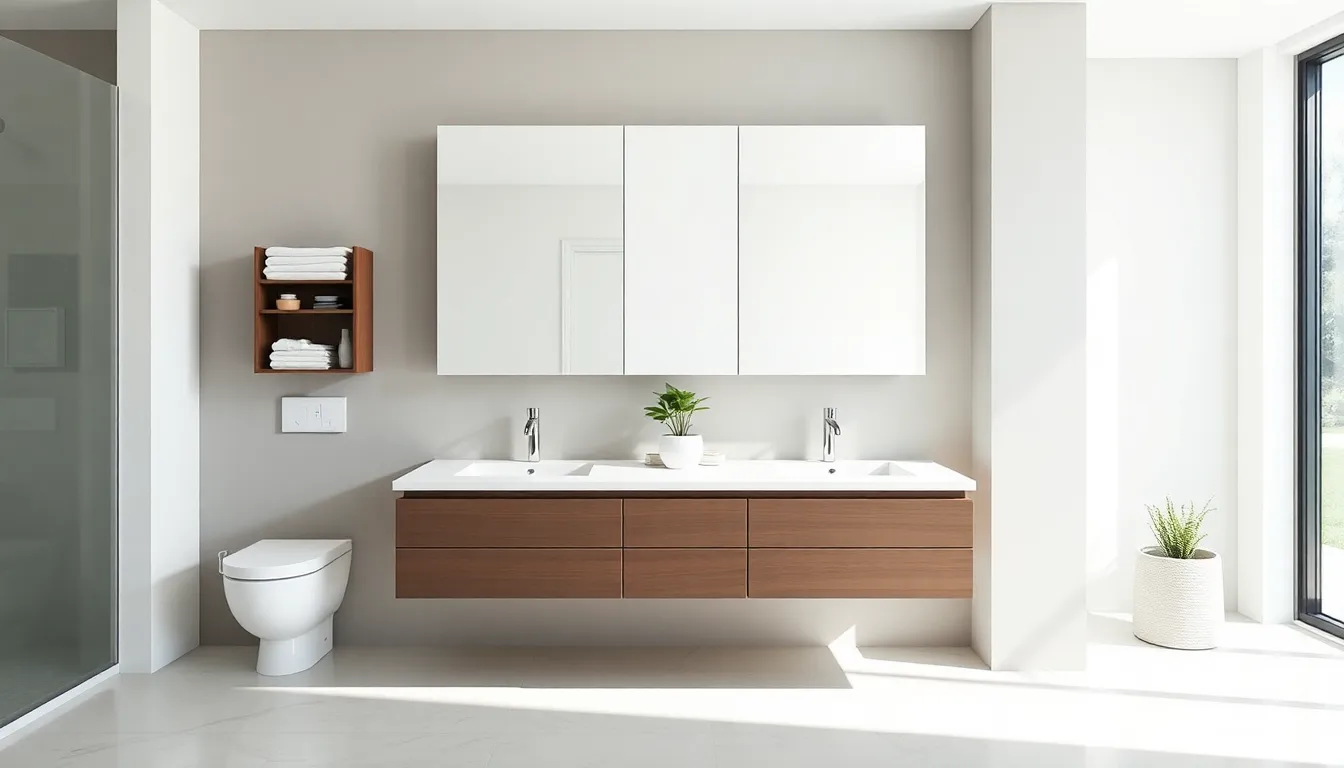
Smart vanity upgrades can dramatically transform your bathroom’s functionality while creating the organized space you’ve always wanted. We’ll explore three key strategies that maximize storage potential and enhance your daily routine.
Double Vanity Installations
Double vanities significantly enhance bathroom functionality by providing more space for personal items and improving traffic flow during busy morning routines. We find this upgrade particularly beneficial in shared bathrooms where multiple people need simultaneous access to storage and counter space.
Installing a double vanity involves removing your existing single vanity and measuring the available area to ensure proper fit for the new fixture. We recommend verifying that your plumbing connections can accommodate the dual sink configuration before beginning the installation process.
The enhanced storage capacity of double vanities means each person gets dedicated drawer and cabinet space for their toiletries and grooming essentials. We’ve seen homeowners report dramatically reduced bathroom clutter and morning conflicts after making this strategic upgrade.
Floating Vanity Designs
Floating vanities deliver a sleek and modern aesthetic while creating the illusion of expanded floor space in your bathroom. We appreciate how these wall mounted designs allow more visible floor area beneath the vanity, making even compact bathrooms feel substantially larger.
Securing the vanity properly to wall studs ensures long term stability and prevents sagging under the weight of countertop materials and stored items. We always recommend professional installation for floating vanities to guarantee proper structural support and prevent costly damage.
The streamlined appearance of floating vanities complements contemporary bathroom designs while simplifying floor cleaning around the vanity area. We’ve noticed that homeowners consistently choose this style when aiming for a clutter free, minimalist bathroom environment.
Medicine Cabinet Upgrades
Medicine cabinet upgrades with larger or more modern designs can substantially improve both storage capacity and accessibility for daily essentials. We suggest considering wall mounted cabinets that free up valuable floor space while providing a sleek, integrated appearance.
Modern medicine cabinets often feature LED lighting, electrical outlets, and adjustable shelving that adapts to your exact storage needs. We find these enhanced features particularly valuable for organizing medications, skincare products, and small grooming tools in an easily accessible manner.
The installation process typically involves removing your existing cabinet and ensuring proper electrical connections for illuminated models. We recommend measuring your available wall space carefully to select a cabinet size that maximizes storage without overwhelming your bathroom’s proportions.
Selecting Water-Saving Fixtures and Faucets
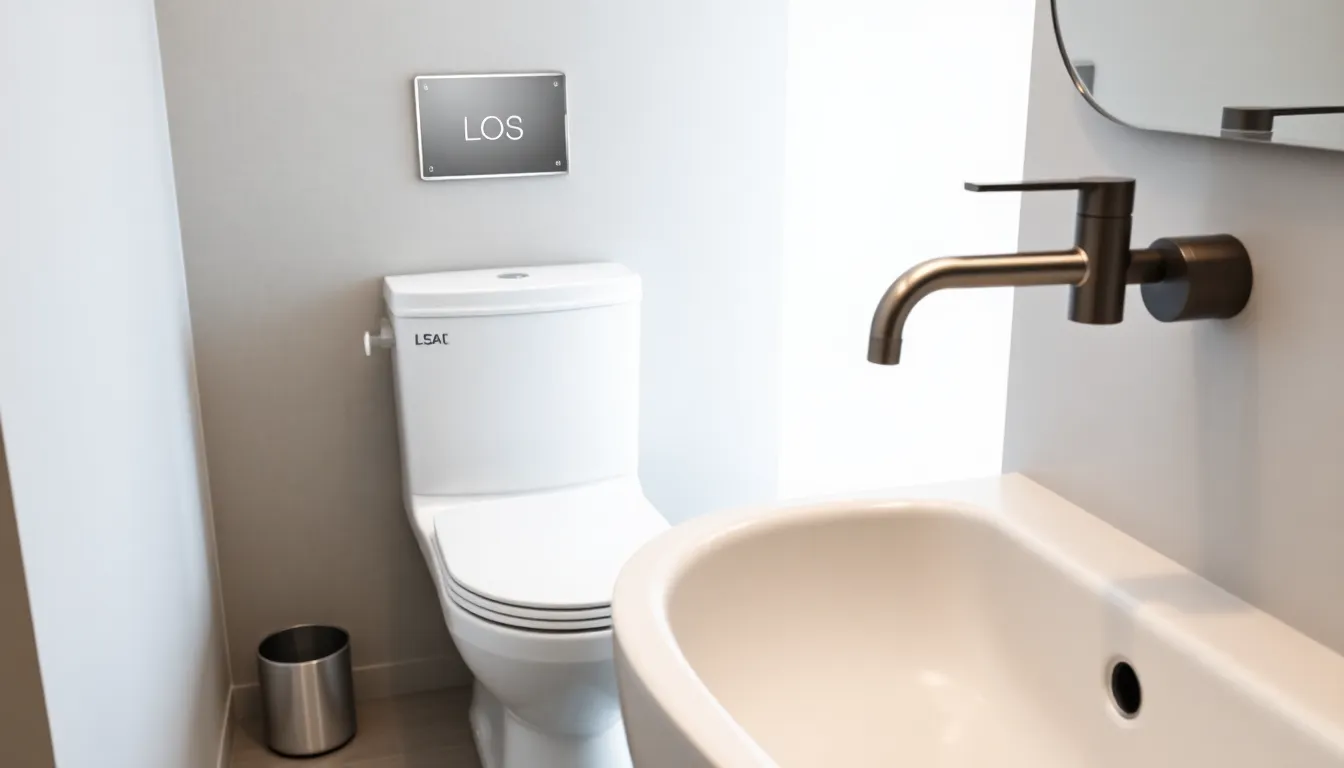
Choosing the right water-saving fixtures transforms your bathroom renovation into an eco-friendly investment that reduces utility bills while maintaining modern functionality. Smart fixture selection allows us to create a sustainable bathroom space without compromising on style or performance.
Low-Flow Toilet Options
Low-flow toilets use significantly less water per flush compared to traditional models, making them essential for water-conscious bathroom renovations. Modern designs feature either single-flush or dual-flush mechanisms that deliver powerful performance while conserving water.
Single-flush models typically use 1.28 gallons per flush or less, representing a substantial reduction from older toilets that consume 3.5 to 7 gallons per use. These efficient fixtures incorporate advanced flushing technology like pressure-assisted systems and optimized bowl designs to ensure complete waste removal.
Dual-flush options provide even greater flexibility by offering two different flush volumes for various waste types. Users can select the appropriate flush strength based on their needs, maximizing water conservation without sacrificing effectiveness.
Installation of low-flow toilets often qualifies for rebates from local water utilities, making these fixtures financially attractive beyond their long-term savings potential. Premium models include features like comfort height seating and easy-clean surfaces that enhance both accessibility and maintenance.
Sensor-Activated Faucets
Sensor-activated faucets automatically control water flow through motion detection technology, eliminating waste from running taps and improving hygiene. These smart fixtures prove particularly valuable in high-traffic areas but offer important benefits in residential bathroom settings.
Motion sensors detect hand movement within a specified range, typically 4 to 6 inches from the spout, activating water flow for preset durations. Advanced models allow customization of sensitivity settings and flow duration to match household preferences and usage patterns.
Battery-powered systems provide reliable operation without requiring electrical connections, making installation straightforward for most bathroom configurations. Some models feature backup manual operation modes that ensure functionality during battery replacement or sensor maintenance.
Water temperature control remains separate from the sensor activation, allowing users to preset their preferred temperature through traditional mixing valves. This design maintains consistent temperature while providing the convenience and conservation benefits of automatic operation.
Sensor faucets reduce water waste by up to 70% compared to traditional manual fixtures, delivering measurable savings on monthly utility bills while supporting sustainable bathroom design goals.
Dual-Flush System Benefits
Dual-flush systems offer two distinct flush volumes that allow users to choose between 0.8 gallons for liquid waste and 1.6 gallons for solid waste. This flexibility significantly reduces overall water consumption while maintaining effective waste removal performance.
Water savings from dual-flush toilets can reach 20,000 gallons annually for average households, translating to substantial reductions in water bills and environmental impact. The lower volume flush handles approximately 80% of bathroom visits, maximizing conservation opportunities throughout daily use.
User control empowers family members to make conscious water-saving choices with each bathroom visit. Clear button markings and intuitive operation make it easy for all ages to select the appropriate flush volume without confusion or hesitation.
Performance reliability in modern dual-flush systems rivals or exceeds traditional single-flush toilets through improved bowl engineering and flush valve design. Manufacturers have refined these systems to eliminate common issues like incomplete flushing or frequent clogs that plagued earlier models.
Retrofit options allow homeowners to upgrade existing toilets with dual-flush conversion kits, providing an affordable path to water savings without complete fixture replacement. These kits typically install in under an hour and offer immediate conservation benefits.
Creating Spa-Like Atmospheres With Design Elements

Transform your bathroom into a peaceful retreat by incorporating exact design elements that create an authentic spa experience. Achieving this luxurious atmosphere requires careful attention to materials, scents, and textures that work together harmoniously.
Natural Stone Accents
Stone materials instantly elevate your bathroom’s visual appeal while providing lasting durability. Marble countertops bring sophisticated elegance to vanity areas, offering timeless beauty that complements both modern and traditional design styles. Granite walls create stunning focal points behind bathtubs or in shower areas, adding natural texture and depth to the space.
Stone tiles transform ordinary floors into luxurious surfaces that feel authentic and spa-like underfoot. These natural materials work exceptionally well in wet environments, providing slip resistance while maintaining their beautiful appearance over time. Consider mixing different stone textures throughout the space to create visual interest without overwhelming the design.
Essential Oil Diffuser Integration
Aromatherapy plays a crucial role in creating the perfect spa atmosphere within your renovated bathroom. Essential oil diffusers fill the space with calming scents like lavender or eucalyptus, immediately transforming the mood upon entering. Position these devices strategically near ventilation areas to ensure proper scent distribution throughout the room.
Modern diffusers come in various styles that complement your bathroom’s aesthetic, from sleek minimalist designs to natural wood finishes. Choose scents that promote relaxation and stress relief, creating a sensory experience that enhances your daily routines. Timer functions allow you to customize the aromatherapy experience based on your schedule and preferences.
Soft Textile Additions
Plush towels and rugs create the cozy, inviting atmosphere that defines luxury spa experiences. Quality materials like Egyptian cotton or bamboo provide superior softness while maintaining durability through frequent washing. Layer different textures throughout the space to add warmth and comfort to hard surfaces.
Window treatments made from soft fabrics like linen or cotton filter natural light gently, creating the perfect ambiance for relaxation. These materials allow privacy while maintaining the bright, airy feeling that characterizes professional spa environments. Choose neutral colors that complement your stone accents and overall design scheme for a cohesive, tranquil atmosphere.
Incorporating Smart Technology Features
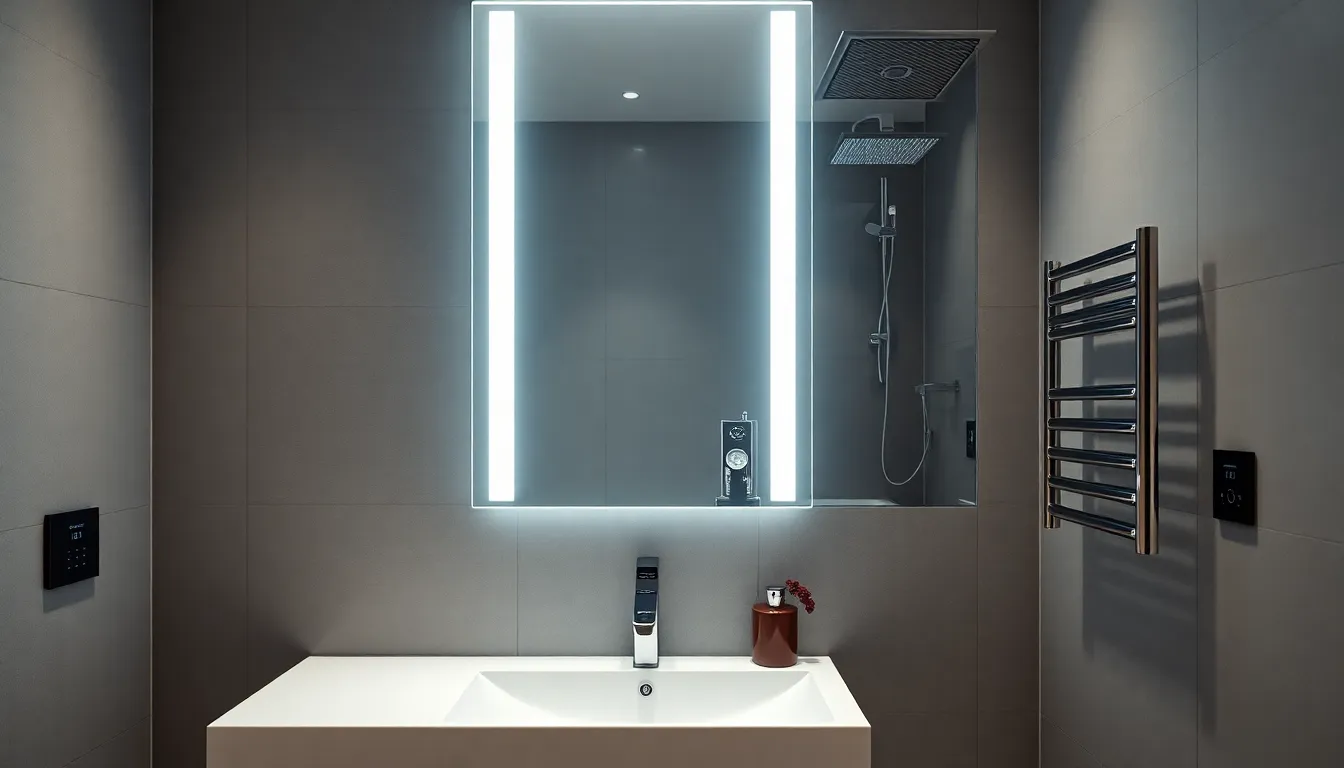
Modern bathroom renovations reach new heights when we integrate cutting-edge technology that transforms daily routines into luxurious experiences.
Bluetooth Speaker Systems
Bluetooth speakers create an immersive audio environment that turns ordinary bathing into a spa-like retreat. Smart shower systems equipped with built-in speakers allow us to stream music, podcasts, or audiobooks directly while we bathe. These waterproof audio answers enhance relaxation and make lengthy soaking sessions more enjoyable.
Installation options include recessed ceiling speakers, wall-mounted units, and integrated shower panel systems. Wireless connectivity eliminates the need for complex wiring, making these systems perfect for both new constructions and retrofit projects. Premium models offer multi-zone audio control, letting us adjust volume and content independently for different bathroom areas.
Smart Mirror Installation
Smart mirrors revolutionize the traditional vanity experience by displaying real-time information while we prepare for our day. These intelligent surfaces show weather updates, news headlines, calendar appointments, and traffic conditions without requiring us to check our phones. Voice command functionality allows hands-free operation, keeping our mirrors streak-free during use.
LED lighting systems built into smart mirrors provide optimal illumination for grooming tasks, with adjustable brightness and color temperature settings. Magnification features help with detailed work like applying makeup or shaving, while skincare analysis tools track our complexion changes over time. These mirrors seamlessly integrate with existing smart home systems, creating a unified technological network.
Automated Ventilation Controls
Automated ventilation systems maintain optimal air quality by monitoring humidity levels and adjusting airflow accordingly. These smart systems prevent mold growth, reduce condensation, and eliminate odors without requiring manual intervention. Sensors detect when we enter the bathroom and automatically activate ventilation based on usage patterns.
Programming options let us customize operation schedules, ensuring the bathroom stays fresh throughout the day while minimizing energy consumption. Advanced models connect to weather monitoring systems, adjusting ventilation intensity based on outdoor humidity levels. Integration with home automation platforms allows remote monitoring and control through smartphone apps, giving us complete oversight of our bathroom’s air quality management.
Adding Eco-Friendly Materials and Finishes
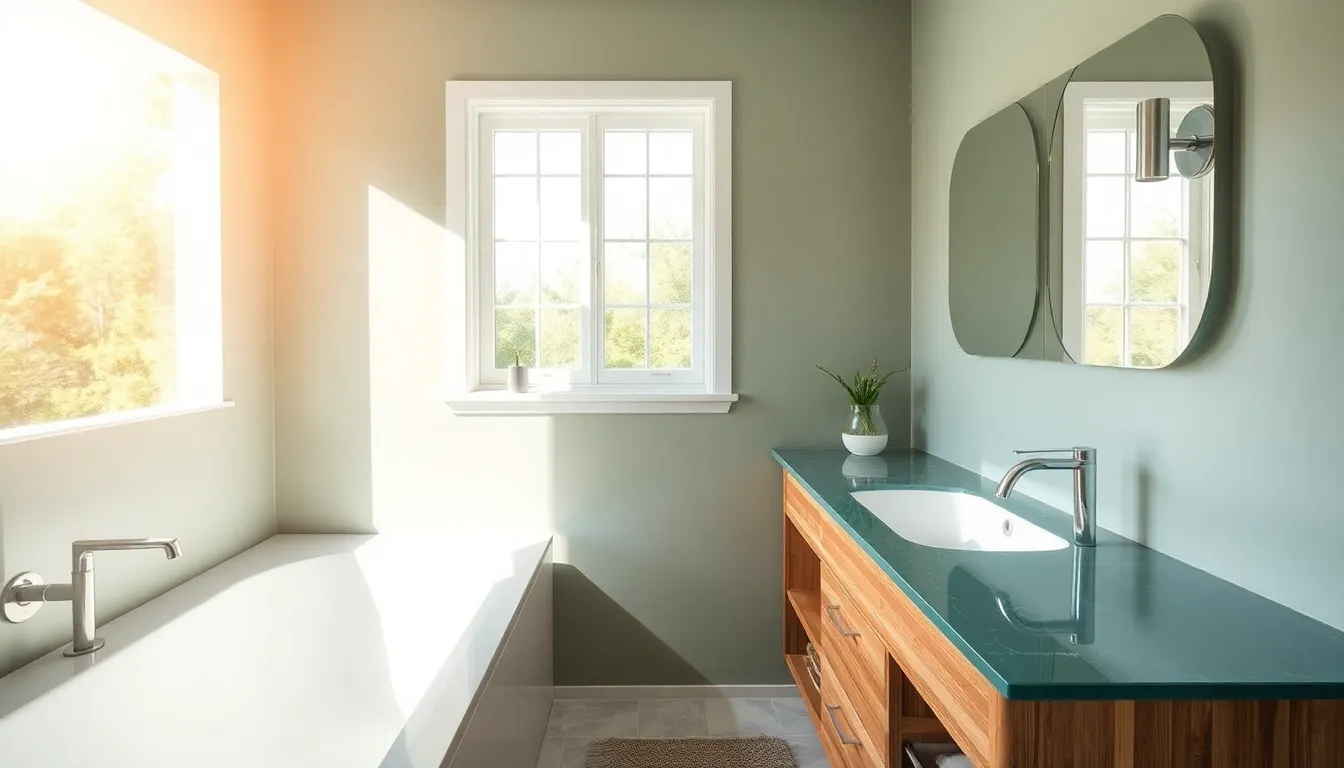
Sustainable materials transform bathroom renovations into environmentally conscious projects that improve indoor air quality while reducing our carbon footprint. We’ll explore three key eco-friendly options that deliver both style and environmental benefits.
Recycled Glass Countertops
Recycled glass countertops combine crushed post-consumer or industrial glass with resin or cement bases to create stunning, sustainable surfaces. These countertops divert glass waste from landfills while requiring less energy to produce than traditional materials.
Durability stands out as a major advantage, with these surfaces resisting scratches, stains, and heat damage better than many conventional options. Easy maintenance makes daily cleaning effortless, requiring only mild soap and water to maintain their lustrous appearance.
Visual appeal varies dramatically based on the glass types and colors incorporated into each slab. Unique patterns emerge naturally from the embedded glass pieces, ensuring no two countertops look identical. Installation costs typically range from $50 to $100 per square foot, making them competitive with other premium surfaces.
Bamboo Vanity Options
Bamboo vanities represent one of the most sustainable choices available for bathroom cabinetry due to bamboo’s rapid growth cycle and renewable nature. This fast-growing grass reaches maturity in just 3-5 years compared to hardwood trees that require decades.
Water resistance improves significantly when bamboo receives proper treatment, making it suitable for humid bathroom environments. Strength characteristics rival traditional hardwoods while offering natural antimicrobial properties that help prevent bacteria growth.
Style versatility allows bamboo vanities to complement both modern and traditional bathroom designs. Natural grain patterns create visual interest without overwhelming smaller spaces. Manufacturing processes for bamboo products generate fewer emissions and support sustainable forestry practices.
Low-VOC Paint Selection
Low-VOC and VOC-free paints minimize harmful chemical emissions that can compromise indoor air quality and trigger allergies or respiratory issues. These formulations reduce volatile organic compounds by up to 95% compared to traditional paint options.
Color selection remains extensive with low-VOC options, offering the same variety and finish quality as conventional paints. Quick drying times allow faster project completion while providing durable coverage that resists fading and wear.
Health benefits extend beyond immediate odor reduction, as these paints continue releasing fewer toxins throughout their lifespan. Environmental impact decreases substantially since low-VOC paints produce less air pollution during application and disposal. Cost differences have narrowed significantly, with many low-VOC options priced competitively with traditional paints.
Conclusion
Your bathroom renovation journey doesn’t have to be overwhelming. We’ve covered everything from budget-friendly updates to luxury spa-like transformations that’ll make your space both beautiful and functional.
The key is starting with a solid plan and choosing upgrades that match your lifestyle and budget. Whether you’re installing water-saving fixtures or adding smart technology features each improvement adds value to your home.
Remember that successful renovations combine style with practicality. Focus on elements that’ll serve you well for years to come while creating the relaxing sanctuary you deserve.
Ready to transform your bathroom? Start with one or two key upgrades and build from there. Your dream bathroom is closer than you think.
Frequently Asked Questions
What is the typical cost range for bathroom renovations?
Small bathroom updates typically cost $5,000 to $15,000, mid-range renovations range from $15,000 to $30,000, and full remodels can reach $30,000 to $60,000. These costs include labor, materials, and should account for a contingency fund to handle unexpected issues during the renovation process.
Should I hire professionals or do a DIY bathroom renovation?
A hybrid approach is recommended for maximum savings and quality results. DIY work can significantly reduce labor costs for simple tasks like painting or installing fixtures, while professional expertise is essential for complex work like plumbing, electrical, and structural modifications to ensure safety and code compliance.
How can I make my small bathroom look bigger?
Use three key strategies: install wall-mounted fixtures to free up floor space, incorporate light colors and mirrors to create an illusion of expansiveness, and add vertical storage solutions like high-mounted shelves. These techniques maximize visual space while maintaining functionality in compact bathrooms.
What are the best flooring options for bathrooms?
Luxury vinyl plank (LVP) and porcelain tile are top choices. LVP offers waterproof properties, durability, and comfort underfoot with easy installation. Porcelain tile provides extreme durability, water resistance, and design flexibility. Both options work well with heated floor systems for added comfort.
How much water can I save with eco-friendly bathroom fixtures?
Low-flow toilets use up to 60% less water than traditional models, while dual-flush systems offer even greater savings by allowing different flush volumes. Sensor-activated faucets reduce water waste by automatically shutting off when not in use, contributing to significant long-term utility savings.
What smart technology features are worth adding to a bathroom?
Consider Bluetooth speaker systems for audio entertainment, smart mirrors with LED lighting and real-time information displays, and automated ventilation controls for air quality management. These features enhance functionality, convenience, and the overall luxury experience while adding modern appeal to your bathroom.
Are eco-friendly bathroom materials worth the investment?
Yes, sustainable materials like recycled glass countertops, bamboo vanities, and low-VOC paints offer long-term benefits. They provide durability, unique aesthetics, and improved indoor air quality while reducing environmental impact. These materials often have comparable costs to traditional options with added sustainability benefits.
How long does a typical bathroom renovation take?
Timeline varies by project scope. Small updates take 1-2 weeks, mid-range renovations require 3-4 weeks, and full remodels can take 6-8 weeks. Factors affecting duration include permit approval time, material delivery schedules, and complexity of plumbing or electrical work required.










